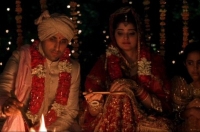‘Bollywood meets Hollywood… and it’s a perfect match’: In love with Bollywood-style weddings
The other day when I was flying back from the SCMS conference in New Orleans (where I convened a panel on ‘Family and Nation in the Age of Globalisation’ – soon to be podcast on this site!), my colleague and fellow traveller Sarita Malik, who knows that I have a professional interest in ‘diasporic wedding films’, recommended The Accidental Husband (2008) to me - ‘because there’s an Indian wedding scene’.
So with nothing better to do and an uncomfortable seat on a long overnight flight, I tuned in. But after ten minutes I thought, surely, in a film starring Colin Firth and Uma Thurman and set in WASP middle class New York, I’ll be waiting in vain for a Bollywood-style wedding… Even when the Uma Thurman character Emma Lloyd aka Dr Love, who counsels couples on the radio about their failing relationships, realizes that her fiancé is not Mr. Right and she falls in love with the firefighter Patrick Sullivan (Jeffrey Dean Morgan), it turns out he’s not of Indian descent, more likely Irish, as his name suggests…But as it so happens, his apartment is above an Indian restaurant, and the Indian owners are his surrogate family, as it were, and their daughter, as it so happens, is getting married – Bollywood style! A rather accidental connection…but a good enough excuse to slip in the spectacle of an exotic wedding.
Then, it was telly supper on Friday night, and since my family occasionally wants to watch something more light-weight than diasporic family movies , we watched our latest dispatch from Lovefilm.com, Eat Pray Love (2010). I got rather interested, even from a professional point of view, since I am currently working on a book chapter entitled ‘Families in Motion’ and had been wondering whether there are (m)any films about spiritual quests in mainstream cinema, comparable to the wonderful road movie Le Grand Voyage (2004), or Monsieur Ibrahim (2003), for example. And then I discover that, although this is not a road movie, it is a film about a spiritual quest, of sorts… The recently divorced Liz Gilbert (Julia Roberts) takes off on a round-the-world trip to find herself and re-learn how to eat (huge amounts of food looking yummier than in any television cookery programme, in Italy), pray (and learn to meditate in just three months, in an ashram in India) and love (clearly the most difficult challenge, in Bali), again. Even though she falls in love with a transnationally mobile divorcee with an import-export business (Javier Bardem) from Australia – rather than an Indian man – Eat Pray Love still manages to slip in a Bollywood-style wedding! Not Liz’s own but that of an Indian woman whom she meets in Gita’s ashram and who dreads the prospect of the arranged marriage. Fortunately, Liz manages to focus all her meditative energies on her Indian friend, so there's a good chance of true love blossoming in this arranged marriage. In any event, this chance encounter provides a plausible pretext for another beautiful Bollywood-style wedding.
So what is it, then, about this fixation upon Bollywood-style – and other exotic weddings? In mainstream cinema, they represent a variation of the surge of white wedding films in the wake of Four Weddings and a Funeral (1994). The rituals, Indian music, vibrant shades or orange and red, beautiful saris and the tradition of henna-painted hands, etc. add an element of spice to a well-worn formula, a bit like ethnic food and world music to our daily lives. Perhaps, there is also an underlying myth that these traditional marriages are more stable because non-western cultures have superior family values. This is certainly an idea touched upon in The Accidental Husband, when fireman Sullivan rushes back to ‘his Indian family’, because family comes first!
In the context of South Asian diaspora culture, Bollywood weddings have become ‘a trademark attraction of contemporary Indian culture’ and have led to a flourishing ‘Bollywood culture industry, marketing a cultural style which extends beyond cinema to an entire range of cultural production, across media like video, television, and print, to lifestyle markers such as fashion, food, and décor’ (Kapur 2009). According to Kavita Ramdaya’s study Bollywood Weddings: Dating, Engagement, and Marriage in Hindu America (2010), Mira Nair’s film Monsoon Wedding (2001) – though not a Bollywood film as such – has become the yardstick by which the Indian-American Hindu diaspora measures the authenticity of a traditional Hindu wedding, suggesting that wedding films fulfil an educational function for diasporic audiences who are losing touch with their parents’ culture of origin. Evidently, Bollywood weddings have enormous crossover appeal, hence the narratively unmotivated wedding scenes in the films mentioned above. To Western audiences, wedding films speak to an ‘anthropological desire for knowledge of and intimacy with the other’ (Desai 2004), while making the other seem more familiar through the universal narrative of heterosexual couple formation.
I will be exploring some of these issues in more depth at the forthcoming conference The Diasporic Family in Cinema (see Events on this website) but, in the meantime, look forward to your comments.
Edited on 04 Apr 2011 around 1pm
Category: Films


